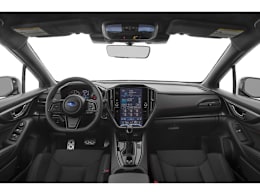The redesigned WRX sticks close to the rally car-inspired formula it established 20 years ago, giving drivers a four-door sedan with a powerful turbocharged engine, road-hugging suspension, and all-wheel drive. It’s a blast to pilot down a tight and twisty back road, but Subaru’s focus on performance comes at the expense of everyday livability, thanks to its stiff ride and noisy cabin. The WRX’s infotainment touchscreen has a few frustrating aspects, as well.
For the current WRX, Subaru swapped the previous 2.0-liter turbocharged four-cylinder in favor of a retuned version of the 2.4-liter turbocharged horizontally-opposed four-cylinder that does duty in the Ascent, Legacy XT, and Outback XT models. The new engine makes a minor gain in peak power, rising from 268 horsepower to 271, but what’s important here is that it’s delivered in a smoother and more predictable manner. The WRX is a speedy little car when fitted with the standard-equipment six-speed manual transmission, shown by its sprint from 0 to 60 mph of just 5.8 seconds. There’s plenty of power on hand when the engine is kept spinning between 3,000 to 6,000 rpm, but it can feel a little lazy at low rpm, especially in taller gears. That’s okay by us; we enjoy the six-speed manual’s robust and accurate feel, even if the gates are a bit notchy. The WRX is far from a fuel-sipper, though; it managed just 25 mpg overall in our testing, running on the required premium fuel. A continuously variable transmission (CVT) is available as an extra-cost option, but it dilutes the WRX’s ultra-sporty demeanor.
Handling is the WRX’s greatest virtue, though. Its 59 mph speed through our avoidance maneuver—a test which simulates swerving quickly to avoid a vehicle or an obstacle on the road—puts the four-door WRX firmly in high-level sports-car territory, matching the speed of the Porsche 718 Boxster, for example. The WRX’s taut suspension and massive levels of tire grip give the car a keen ability to gobble up curvy back roads, while the standard all-wheel drive puts the power down like a cat on Velcro.
But the WRX isn’t a friendly companion on long journeys. Underlying it all is a super-stiff ride that becomes a punishment even on a mildly bumpy road. The cabin suffers from elevated levels of road, tire, and engine noise, and the exhaust resonance that occurs when first starting the car proved nearly unbearable for some of our drivers.
The front seats are short on adjustments and not all that big on long-haul comfort, although they have ample side bolsters to hold occupants in place through corners. We appreciate the fairly upright driving position which, in combination with the tall roof and large windshield, affords a good view out over the hood, an easy reach to the controls, yet also plenty of headroom. But, the center armrest is positioned so low and rearward that it’s basically unusable, and the plastic center console hems in the driver’s right knee. The WRX’s rear seat is reasonably comfortable, thanks to decent leg support, pretty good foot space under the front seats, and a seatback rake that isn’t overly upright.
Most of the regular controls within the cabin are logically placed and easy to use. But we don’t like the slow-responding, 11.6-inch infotainment screen (standard on all trims above the base model), or that many of the climate functions integrated into it require multiple steps to use. For instance, pressing on the seat-heat button brings up a separate pop-up menu from which you need to tap more buttons, instead of just immediately activating the heat upon the first press. Also, many of the climate-control “buttons” on the infotainment screen are overly small, which, combined with the WRX’s stiff ride, makes them difficult to pinpoint on the first try.
For 2025 DriverFocus Distraction Mitigation System is standard on all trims. All WRX models come standard with forward collision warning (FCW), automatic emergency braking (AEB) with pedestrian and cyclist detection, lane centering assistance (LCA), lane departure warning (LDW) and and lane keeping assistance (LKA). Blind spot warning (BSW), rear cross traffic waring (RCTW) and adaptive cruise control (ACC) are optional.


























